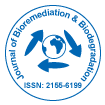Leveraging Bioinformatics in Bioremediation: Computational Strategies for Enhancing the Degradation of Environmental Pollutants
*Corresponding Author:Received Date: Jan 01, 2025 / Published Date: Jan 30, 2025
Copyright: © 0 . This is an open-access article distributed under the terms of the Creative Commons Attribution License, which permits unrestricted use, distribution, and reproduction in any medium, provided the original author and source are credited.
Abstract
The growing environmental concerns associated with pollutants such as heavy metals, pesticides, and industrial B i o chemicals have accelerated the search for effective bioremediation techniques. Bioinformatics, an emerging field at the intersection of biology and computational science, offers powerful tools to enhance the biodegradation of these pollutants. This review discusses the application of bioinformatics in bioremediation, focusing on computational strategies used to identify, analyze, and optimize microbial species and metabolic pathways responsible for pollutant degradation. By integrating genomic, transcriptomic, and proteomic data, bioinformatics facilitates the discovery of novel microbes with pollutant-degrading potential and enhances the understanding of microbial communities involved in bioremediation processes. Furthermore, computational models and machine learning techniques are explored for predicting the behavior of microbial consortia in complex environments, ultimately aiding in the design of more efficient and sustainable bioremediation strategies. The review highlights the current advancements and challenges in this field and suggests future directions for bioinformatics-driven approaches to improving environmental remediation efforts.

 Spanish
Spanish  Chinese
Chinese  Russian
Russian  German
German  French
French  Japanese
Japanese  Portuguese
Portuguese  Hindi
Hindi 
